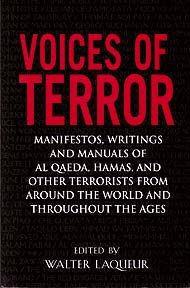 This information has been archived for reference or research purposes.
This information has been archived for reference or research purposes.
Archived Content
Information identified as archived on the Web is for reference, research or recordkeeping purposes. It has not been altered or updated after the date of archiving. Web pages that are archived on the Web are not subject to the Government of Canada Web Standards. As per the Communications Policy of the Government of Canada, you can request alternate formats on the "Contact Us" page.
Book Reviews
voices of terror: manifestos, writings and manuals of al qaeda, hamas, and other terrorists from around the world and throughout the ages
Walter Laqueur (ed)
New York: Reed Press, 2004
520 pages, $29.95 (Trade paperback)
Reviewed by Colonel Bernd Horn
For more information on accessing this file, please visit our help page.
 Noted author and historian, Walter Laqueur, has once again produced an important work on terrorism and guerrilla warfare. This book, however, draws largely from his previous work with only the third part, “The Origins of Twenty-First Century Terrorism,” representing completely new material. Nonetheless, this should not detract from the volume’s importance.
Noted author and historian, Walter Laqueur, has once again produced an important work on terrorism and guerrilla warfare. This book, however, draws largely from his previous work with only the third part, “The Origins of Twenty-First Century Terrorism,” representing completely new material. Nonetheless, this should not detract from the volume’s importance.
In this latest effort, Laqueur undertakes a historical examination of political violence, terrorism and guerrilla warfare. Its strength is in his approach – he uses excerpts of the actual writings and manifestos of the theorists, revolutionaries and terrorists themselves. Therefore, the readers are able to draw their own conclusions, inferences and understanding rather than relying on the analyses and interpretations of others. In this regard, the book is rich with writings, manifestos and proclamations that provide a unique window on the history of the ethics, morality and utility, as well as techniques, in regard to using violence as a tool for political change.
Key to Laqueur’s work is his premise that terrorism has been largely misunderstood. He notes that the prevailing belief has always been that terrorism is an ideology. However, he argues that it is a strategy, and, as such, it is not a “static phenomenon.” He explains that what is true in regard to terrorism for a specific organization in one country at a certain point in time is not necessarily effective for another at another time or on another continent. Laqueur insists that specific political, social and cultural conditions predicate the way in which terrorism can be understood in a given situation.
Interestingly, Laqueur observes that terrorism has “lasted only when it functioned within the framework of a wider political movement or when it was supported by powerful outside forces.” He also notes that terrorism is a weapon that only can be used effectively against democratic regimes.
The book is not geared toward the neophyte or casual reader in terrorism or guerrilla warfare, or anyone who is searching for a quick, succinct definition, or a clear, easy-to-follow historical overview of terrorism or guerrilla warfare. Although many of the contributions are extremely powerful, and all of them are enlightening, together they do not necessarily flow to tell a self-evident story. Although the introductions to the respective sections are exemplary, it is still necessary for the reader to draw the necessary messages, nuances and meanings, and put the entirety of the work into perspective.
Additionally, the title itself is somewhat misleading. It purports to contain the words of “terrorists” throughout the ages, which it does. However, not all contributions fit into that category. Many writings are by revolutionaries and theorists who would rail at this branding or categorization. Equally, the title, in relation to the content, raises the question of equating terrorism with revolution as synonymous concepts, rather than terrorism as a tactic of those seeking regime change. Furthermore, one-third of the book, Part II, deals exclusively with guerrilla warfare – theory, practice and methodology – and its linkage to the title is a bit strained. Notwithstanding that, Part II is easily the most comprehensive and self-evident of the three parts of the book, and it provides a solid primer on guerrilla warfare and partisans.
In the end, Voices of Terror, in the tradition of Laqueur’s work, is an excellent volume that is a must read for the serious scholar, security analyst or practitioner of national security. In bringing together the thoughts, declarations, ideology and writings of 120 of history’s most controversial figures, militant organizations and guerrilla groups, as well as respected military theoreticians, Laqueur has provided a powerful depiction of the politics, psychology and methodology of terrorism and guerrilla warfare. This book is well worth its price and the time it takes to read it.
![]()
Bernd Horn is Director of the Canadian Forces Leadership Institute.






